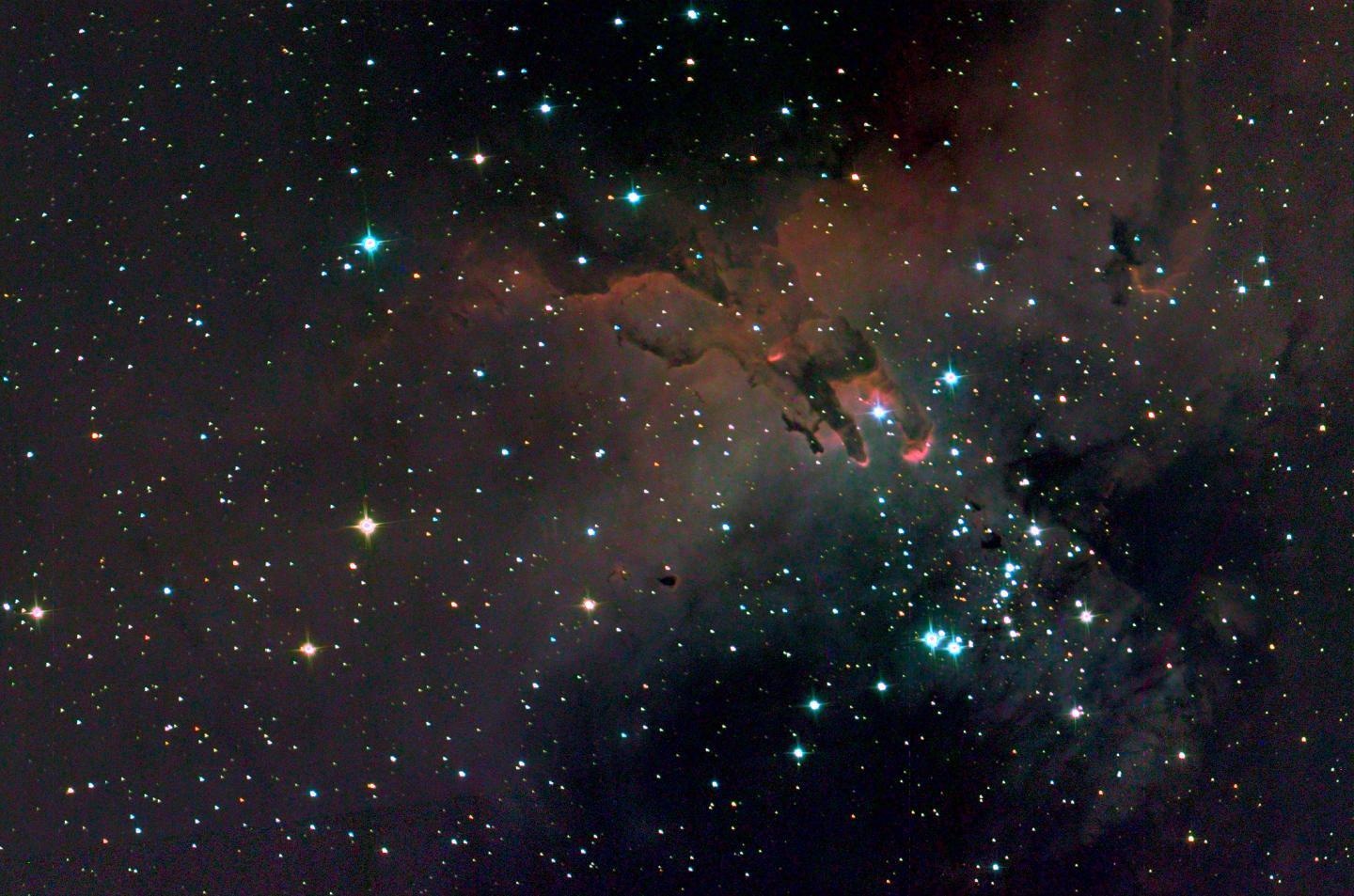A new type of astronomical telescope has been developed by Durham, Toronto and Princeton University in collaboration with NASA and the Canadian Space Agency.
 A SuperBIT optical and ultraviolet composite image of the “Pillars of Creation,” trunks of gas and dust in the Eagle Nebula, 7,000 light years away in the direction of the constellation of Serpens. Image Credit: SuperBIT team, from Romualdez et al. (2018) SPIE 10702.
A SuperBIT optical and ultraviolet composite image of the “Pillars of Creation,” trunks of gas and dust in the Eagle Nebula, 7,000 light years away in the direction of the constellation of Serpens. Image Credit: SuperBIT team, from Romualdez et al. (2018) SPIE 10702.
The flying height of the SuperBIT is above 99.5% of the Earth’s atmosphere, carried by a helium balloon which is equal to the size of a football stadium. The telescope is all set to make its operational debut in April 2022, and when deployed, it must achieve high-resolution images competing with those of the Hubble Space Telescope.
Mohamed Shaaban, who is a PhD student at the University of Toronto, will explain the SuperBIT in his talk on Wednesday, July 21st, 2021, at the online RAS National Astronomy Meeting (NAM 2021).
Light coming from a faraway galaxy has the ability to travel for billions of years to reach the telescopes. The light has to pass via the swirling and turbulent atmosphere of the Earth in the final fraction of a second. The view of the universe turns out to be blurred. Observatories on the ground are constructed at a great height to overcome some of these issues, but so far, just placing a telescope in space escapes the impact of the air.
The Superpressure Balloon-borne Imaging Telescope (or SuperBIT) consists of a mirror with a diameter of 0.5 m and is carried to an altitude of 40 km by a helium balloon with a volume of 532,000 m3, which is almost the size of a football stadium.
Its last test flight in 2019 illustrated remarkable pointing stability, with a variation of below one thirty-six thousandth of a degree for over an hour. This must allow a telescope to achieve sharp images similar to those obtained from the Hubble Space Telescope.
So far, no one has achieved this, not just due to its high complexity but also because balloons could only stay high up for only a few nights: not enough time for an ambitious experiment. Yet, NASA has recently developed “superpressure” balloons that have the potential to hold helium for several months.
The launch of SuperBIT has been planned for the next long-duration balloon, from Wanaka, New Zealand, in April. It will be carried by seasonally stable winds and will circumnavigate the Earth many times to image the sky all night. It will use solar panels to recharge its batteries during the daytime.
The budget for construction and operation of the first SuperBIT is US$5 million (£3.62 million), costing nearly 1000 times less compared to a similar satellite. Apart from being affordable compared to rocket fuel, the balloons' potential to return the payload to Earth and relaunch it, implies that its design has been fine-tuned and enhanced over several test flights.
Satellites must function first time, so they normally have (very expensive) redundancy, and decade-old technology that had to be space-qualified by the earlier mission. Advanced digital cameras keep enhancing annually, so, the development team arranged for the cutting-edge camera for SuperBIT’s latest test flight a few weeks before launch. This space telescope will keep upgrading, or contain new instruments on every flight in the future.
The Hubble Space Telescope will not be repaired again when it inevitably fails. For two decades after that, ESA or NASA missions will allow imaging only at infrared wavelengths (like the James Webb Space Telescope that will be launched this autumn) or a single optical band (like the Euclid observatory that will be launched in 2022).
By that time, SuperBIT will be the only facility in the world that would be capable of high-resolution multicolor optical and ultraviolet observations. Already, researchers have received financial support to design an upgrade from SuperBIT’s 0.5 m aperture telescope to 1.5 m (the balloon’s maximum carrying capacity is a telescope with a mirror measuring around 2 m across).
By boosting light-collecting power 10 times, along with its wider angle lens and more megapixels, the bigger instrument will be even better than the Hubble. The affordable cost even makes it viable to have a fleet of space telescopes providing time to astronomers throughout the world.
New balloon technology makes visiting space cheap, easy, and environmentally friendly. SuperBIT can be continually reconfigured and upgraded, but its first mission will watch the largest particle accelerators in the Universe: collisions between clusters of galaxies.
Mohamed Shaaban, PhD Student, University of Toronto
The science goal for the 2022 flight is to quantify the properties of dark matter particles. Dark matter is invisible, but astronomers map the manner in which it bends rays of light, a method termed gravitational lensing.
SuperBIT will investigate if dark matter decelerates during collisions. No particle colliders on Earth can expedite the dark matter, but this is the main signature estimated by theories that may account for recent observations of oddly behaving muons.
Cavemen could smash rocks together, to see what they’re made of. SuperBIT is looking for the crunch of dark matter. It’s the same experiment, you just need a space telescope to see it.
Richard Massey, Professor, Durham University